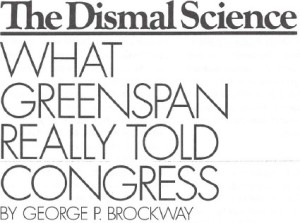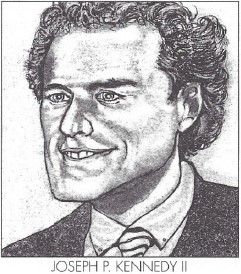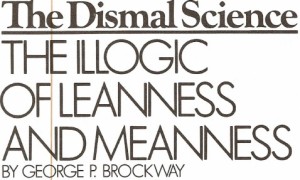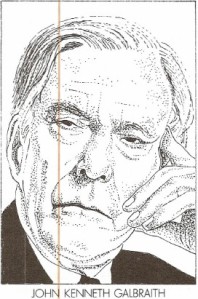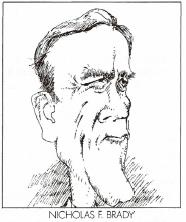By George P. Brockway, originally published January 11, 1999
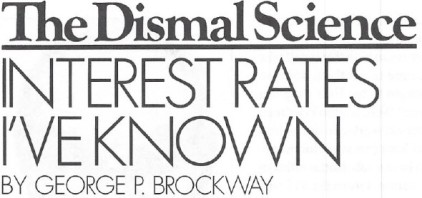 FRIENDS have been congratulating me on bringing the Federal Reserve Board around to my way of thinking about the interest rate. It is, to be sure, true that over the years I have scolded Chairman Alan Greenspan many more times than once about his interest rate policy, and that I scolded his predecessor, Paul A. Volcker, even more harshly (because his notions were indeed worse). Well, I am still at it: I don’t think the Federal Reserve Board has gone far enough.
FRIENDS have been congratulating me on bringing the Federal Reserve Board around to my way of thinking about the interest rate. It is, to be sure, true that over the years I have scolded Chairman Alan Greenspan many more times than once about his interest rate policy, and that I scolded his predecessor, Paul A. Volcker, even more harshly (because his notions were indeed worse). Well, I am still at it: I don’t think the Federal Reserve Board has gone far enough.
Greenspan himself had the Federal Funds rate lower than it is at present from November 1991 through November 1994, and he kept it hovering around 3 per cent from mid-1992 through early 1994. Somehow it seems impossible for most people, especially financial reporters and bankers’ advertising agents, to remember what happened that long ago. Every day we read in the business pages that truck and minivan sales are responding vigorously to the current “low” interest rates, and that the real estate market is strong thanks to “low” mortgage rates. Commercials running on television have been touting mortgages at 6.5 per cent as “the lowest they’ve ever been!”
My own memory goes back somewhat farther. In 1940, like millions of our fellow citizens, my wife and I had an FHA mortgage at 4 per cent. In 1947, we refinanced it with a GI mortgage that started at 4 per cent and ultimately dropped to 3.5 per cent. At that time, anything above 6 per cent was condemned as usury by state law.
In 1947, too, I became a junior officer of a small firm and quickly learned the importance of a low interest rate to any company whose business is at all seasonal (you borrow money in one half of the year and pay it back in the next). The prime rate (what the majority of banks charge their most reliable customers) was then 1.5 per cent (it is now 7.75 per cent).
Two years later the prime was up to 1.75 per cent. I remember especially the concern with which our legal counsel telephoned us a few months later to tell us that he had just seen on the ticker that the prime had jumped to 2 per cent. He strongly recommended that we raise prices and go slow with some of the projects we were working on.
The point I’m trying to make is that, contrary to what you read in the newspapers or hear on the radio or TV, interest rates in this country are high by historical standards. They are higher than they have been in most of the years since the end of World War II, higher than in most of the years since the creation of the Federal Reserve Board in 1913, higher than of the Constitution.
In fact, they are so high that it will take a good long time to get them down to where they ought to be. How long is a good long time? Well, Milton Friedman says his empirical work convinces him that it takes at least two years for monetary policy to have a substantial effect in the world of action. Given the $15 trillion of mortgages, bonds and other long term indebtedness now outstanding, and given the number of leases and other long-term contracts with settled prices, I expect it will take nearer five years, and perhaps 10, to squeeze an appreciable amount of the inflation out of the system.
AS I HAVE SAID many times before, our capitalist system runs on borrowing, and borrowing is paid for by interest. Interest is a direct or indirect cost of every business and every farm in the land. The direct cost is what you pay to whoever lends you money. The indirect cost (technically termed “opportunity cost”) is what you pay yourself for using your own money in your own business, instead of taking the opportunity of lending it to another firm and making an effortless profit from the interest you would receive. Your business has to earn its opportunity cost, or it is not worth doing, except for fun; and it has to earn the direct cost, or it goes bankrupt. I’m all for having fun running a business (or a farm, though that seems more like hard labor to me)-after all, it is how you spend most of your waking hours-but you have to pay for it directly or indirectly or both.
Direct and indirect interest costs are therefore factors in the prices you charge. They are not the only factors, but they are unavoidable factors. You can’t escape them. If the interest rate falls, competition is likely to persuade you to lower your prices. If the interest rate goes up, the prices you charge have to go up too, or your profits go down.
In all this, you are not alone. That’s the way our economy works, and it works better than any other yet invented. But, to paraphrase President Calvin Coolidge, as I like to do, when many people raise prices, inflation results.
Last year, and for at least the past half century, the total indebtedness of the nonfinancial sectors of the economy ran fairly close to double the Gross Domestic Product. On this basis, a shift of one percentage point in the interest rate should cause a shift of almost two percentage points in the price level. Like most economic calculations, this one is far from precise. There are too many gaps and lags and crosscurrents and arguable assumptions and downright errors in the statistics.
We don’t need precision in this case, however. We merely need a direction, because the desired end is an interest rate barely high enough to cover transaction costs (which will, I hasten to say, include loan officers and clearinghouses and deposit insurance and much of the other paraphernalia of modern banking). The record here is so clear that it does not overstate the matter to say that a rise of one percentage point in the interest rate will cause a rise of at least one percentage point in the price level, and that a fall of one percentage point in the interest rate will cause a roughly corresponding fall in the price level. (Constant readers will recognize that the foregoing is a restatement of what appeared in this space 10 years ago as “Brockway’s Law No.2: Raising the interest rate doesn’t cure inflation; it causes it.”)
WELL, as you have no doubt guessed, I am in favor of the Federal Reserve Board continuing the policy of nibbling away at the interest rate started last summer. It might be risky to do this too fast, but it should be done steadily, and there is a recent example that should give the Board confidence. The Reserve brought the Federal Funds rate down from 9.21 per cent in 1989 to 3.02 per cent in 1993. That is a fall of about 67 per cent in four years. Such a fall, starting today, would give us in 2003 a Federal Funds rate of 1.5 per cent-just about what it should be.
Also in the years from 1989 to 1993, the annual change in the Consumer Price Index fell from 4.6 per cent to 2.7 per cent, a fall of about 60 per cent. This may be little more than a coincidence, rather than a consequence of the fall in the Federal Funds rate, but at least it’s a happy one and does not contradict our theory that the interest rate and the inflation rate tend to go up and down together, with the former causing the latter.
There are certainly occasional cases where a short supply, natural or man-devised, of a quasi-essential resource allows the ancient “law” of supply and demand to drive a particular price up, whereupon a one-time shock runs through the economy. In ordinary commerce today, though, price is the independent variable, usually set by the seller, while supply and demand are dependent upon it.
If the foregoing analysis is correct, the role of the Federal Reserve Board should be largely restricted to regulating banking (or some of it), to running a clearinghouse, and to maintaining a truly low and steady pattern of interest rates in order to stabilize the price level. Most of the other great desiderata of a good economy must necessarily be left to Congress and the President, provided they can get their minds off sex.
The New Leader
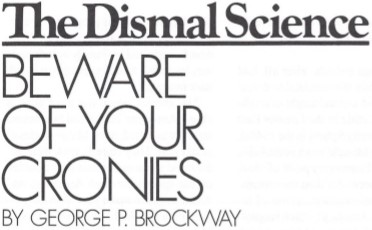
 What’s so new about all that?
What’s so new about all that? 